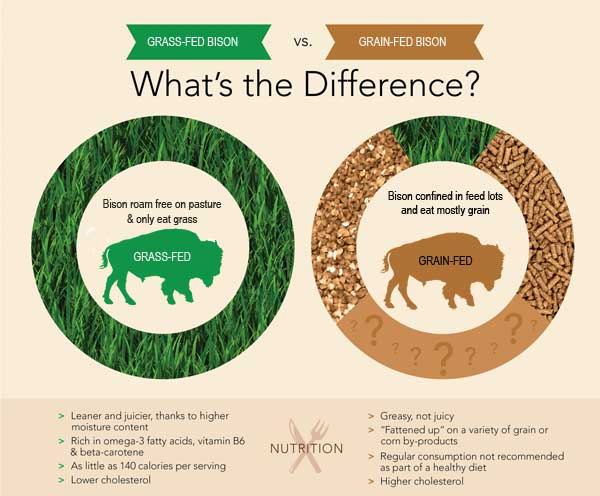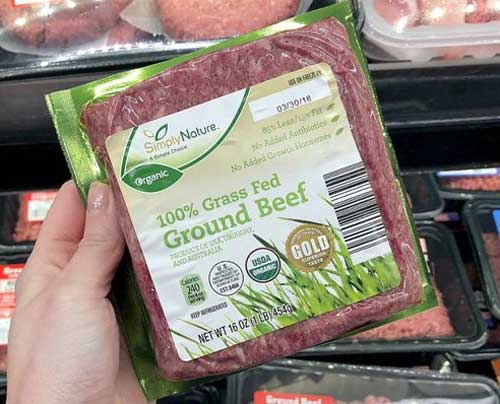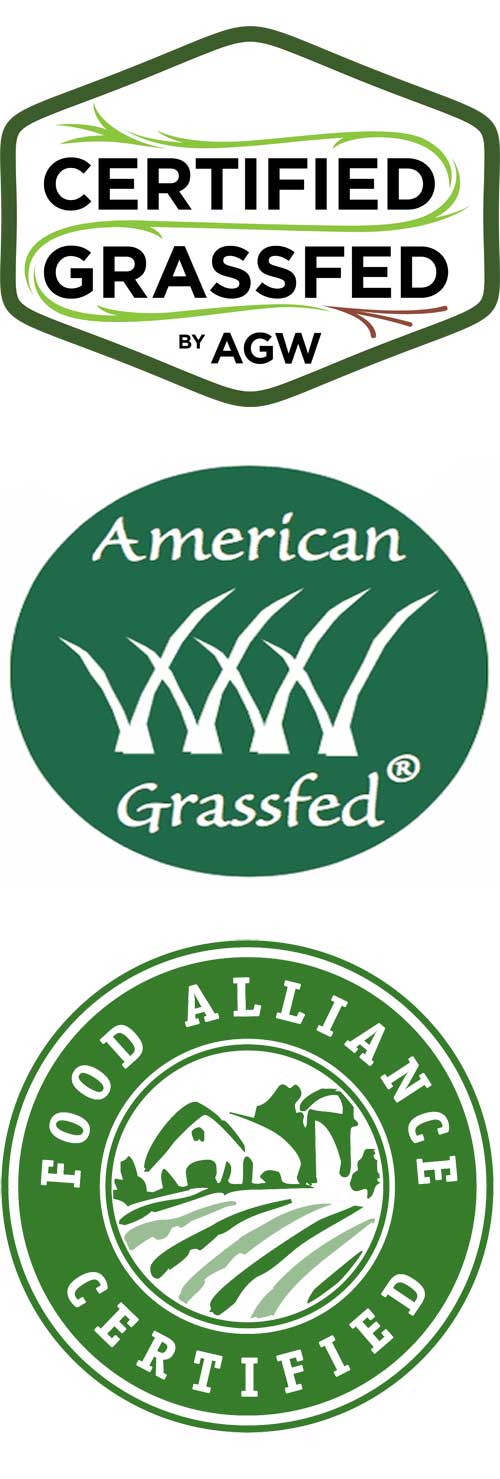Grass-Fed Meat. What does it Mean?
Do you raise grass-fed bison and/or beef? Do you have customers that seek grass-fed meat? What are the differences between grass-fed, grass-fed grain-finished, and grain-fed grass-finished animals? What is a grass, a grain, a grain by-product in terms of the grass-fed claim? Do you make grass-fed claims? What are the standards? Are there standards? Can grass-fed animals get a "little" grain, occasional range cubes, or protein supplements? These are all questions that are misunderstood by consumers and producers alike.

All ruminants, including bison, eat grass, after all. It's what they do, and what they have done for centuries. So aren't all ruminants and bison "grass-fed"? For this reason, the term has become somewhat meaningless, cryptic, and possibly even deceitful.
Grass-fed meat is expensive. For beef, it costs on average about $2.50 to $3 more a pound than conventional supermarket beef according to Consumer Reports. For bison, the average cost of grass-fed bison is almost $15.00 a pound. Why is grass-fed meat so much more expensive?
Typically it takes a year longer to fatten grass-fed beef cattle to slaughter weight than for conventional grain-fed cattle. This extra time commitment drives up feed and labor costs. In addition, even when grass-fed animals reach slaughter weight, they still tend to be smaller than their grain-fed relatives. Less meat means less money in the producer's pocket. To recuperate sunken costs, farmers need to increase prices to compensate which gets passed on to the consumer. Our certified grass-fed bison bulls only weigh 800-900 pounds at 24-30 months and heifers substantially less. That is compared to grain-fed that weight 1,200 pounds or more.
Evidence suggests that grass-fed meat is healthier, more nutritious, and less likely to carry harmful bacteria than grain-fed meat. Three decades of studies around the world have concluded that grass-fed meat is not only lower in total fat content than grain-fed meat, but the kinds of fats it does contain are healthier and less likely to raise cholesterol than grain-fed meats It also found that grass-fed meat is higher in cancer-fighting antioxidants and essential vitamins, such as vitamin A, than conventionally grain-fed meat. There are also reports that grass-fed meat was three times less likely to harbor multidrug-resistant bacteria than conventionally raised grain-fed meat.
If a consumer is willing to spend the extra money for grass-fed meat, how can they be assured of what they are paying for? Unfortunately, the consumer is left to figure out if the meat they are buying is really grass-fed within the context of their understanding of what a grass-fed animal should be. I recently dealt with a customer who had been buying grass-fed bison online for over 5-years only to recently learn that the bison were being fed corn. Although corn is technically a grass, feeding corn is not appropriate to a grass-fed claim.

Is this meat really grass-fed? Why isn't it certified? Organic is not the same as grass-fed. Is this meat from Australia, Uruguay, or the US or a mixture of all. Is Uruguay's understanding of grass-fed the same as yours?
In 2016, the US Department of Agriculture dropped its official definition of "grass-fed" claiming that it doesn't have the authority to define and determine whether specific grass-fed claims that companies make on their packaging are "truthful and not misleading." That means that, while the USDA still evaluates and approves grass-fed claims, the government no longer has an official definition of the term "grass-fed," which means the phrase is open to interpretation.
The American Grassfed Association, an organization that originally helped USDA develop its official grass-fed definitions suggested that "... grass-fed will become just another feel-good marketing ploy used by the major meat-packers to dupe consumers into buying mass-produced, grain-fed, feedlot meat" and suggested that the USDA's withdrawal of the grass-fed marketing claims was a result of "pressure from big cattle producers".
Because USDA no longer has a grass-fed definition or program, consumers must rely on certification by independent third-party groups or on what the producers say. In other words, the burden lies on the buyer to ensure a meat product is what it says it is.
The presultroblem is that meat that isn't 100% grass-fed can pass through bureaucratic regulatory loopholes. Rather than go through a rigorous third-party verification process, a "grass-fed" producer can make their claim directly with the Food Safety and Inspection Service (FSIS), answer a few questions, supply a sample label and related paperwork, and FSIS will decide from those documents whether the claim is truthful and not misleading. FSIS does not do on-site audits or inspections and has no standards or definitions - it's a subjective process that's open to interpretation. Who are they to question a major feed chain when they have no definitions or standards? In short, you can no longer assume that any package labeled as grass-fed is truly grass-fed.
Most (75%-80%) of all the grass-fed beef sold in the United States comes from Australia, New Zealand, and a host of South American Countries. Much of this meat comes from cattle raised in grass feedlots, where they are confined in pens and fed grass pellets and other "grasses". There is no inspection, no audits – it is left to you whether or not you believe the rancher and distributor. For example, Aldi Grocery 100% grass-fed beef may be from animals originating from the US, Australia, and/or Uruguay. Does Uruguay have the same definition as you do? Do you think this meat is really grass-fed? Is there any way to verify? What are their standards and definitions of grass fed? None of this can be determined, let alone verified.

Third party certifications with defined standards insure that the producer understands and abides by grass-fed standards.
In addition to the problems with the actual marketing claims of grass-fed, are the definitions of grass-fed and grass. Similar to the definition of grass-fed that can be ambiguous, so can the definition of "grass" itself. After all, all of your cereal grains, even corn, are grasses.
I have heard many stories from "grass-fed" farmers and ranchers including:
- "Grass-fed simply means we do not feed any grain."
- "Grain by-products are not the same as feeding grain."
- "I only feed my animals a little bit of grain."
- "I only supplement my grass-fed animals with protein tubes (containing urea) and a small amount of grain by-products."
- "We just feed a small amount of range cubes to keep our animals accustomed to us and to move them into different areas."
- "We do provide some supplements in addition to hay and pasture."
- "It is okay to feed grain if it is part of the whole plant."
- "Our grass-fed animals get fat from grazing on wheat and corn fields which are grasses."
At the GTSS, an animal description stated "Grass-Fed supplemented with grain". And so on. Everything is up to the interpretation of the farmer and rancher and what they think is grass-fed.
Adding insult to injury, in December 2015, the USDA stopped enforcing the Country of Origin (COOL) requirements for beef and pork (bison were never included in COOL). As a result, since then, meat that comes in from other countries can be legally sold as a "Product of U.S.A.," or labeled "Made in the U.S.A.," even if it's only been repackaged in the U.S.A. Will we soon be seeing grass-fed bison from Mexico, or maybe even Serbia, without being told where they come from or what their definition of grass-fed may be?
In other words, just because it says grass-fed or the farmer-rancher claims they are grass-fed, does not necessarily mean the animal is grass-fed within the context of what you understand a grass-fed animal should be or even that the animal was raised in the United States.
By far the best way to ensure your meat's quality is to buy from a local farm or a producer you know and trust. Ideally, you'd be able to vet their practices yourself and determine if they are really grass-fed within your understanding. Ask questions and look at their operation.
But if that's not possible, you should look for trusted third-party verification on the package - such as the American Grassfed Approved logo, Certified Grassfed by A Greener World logo, or Food Alliance certification. These independent third-party Grassfed certifications review and approve product claims through on-site inspections and audits. There are other less-known third-party certifications available, often through Organic labeling, but organic is not the same as grass-fed and the standards of these certifications should be examined.
I commonly ask "Grass-Fed" Co-Ops, Farm-to-Table, and distributors why they are not Certified Grass-Fed and the most common response I get is that it is cost prohibitive. When pressured as to what are their grass-fed standards, responses are generally vague. Since cost is not prohibitive and without defined detailed standards, the only reasonable conclusion from these responses is that each farmer of the Co-Op defines their own standards as what constitutes grass-fed.
We are certified Grass-fed by A Greener World (agreenerworld.org) whose standards are similar to other third-party certifications and are well defined. Make the effort to read their standards and understand what Grass-Fed really means and the industry standards of Grass-Fed. Anything that does not meet these standards are not Grass-Fed.
We are audited with on-site inspections annually. Essentially no animal marketed under a Certified GrassFed Label can ever receive any grain or grain-byproduct at any time in its life and can only be fed a strict forage diet. Even feeding grain to a nursing cow is considered feeding the calf grain and the calf cannot be marketed as GrassFed. While the regulations may seem stringent at first glance, they are rather simple: feed an exclusive forage diet without cheating. It is just simpler not to even have any grain on the premise. The cost is only about $200 per year, similar to other certifications, which is certainly affordable. Thus, the cost or the requirement burdens are not valid excuses.
We are also Certified Grass-Fed by USDA but only for name recognition as their "standards" are far less stringent than A Greener World.
That being said, there are some ranchers marketing grass-fed bison with integrity who do not hold a certification either because they are too small to manage the cost and administrative burden, because they have very close relationships with their buyers and don't think they need it, or because they just don't believe in it.
As a producer you may want to take the extra step to assure your customers that they're getting high-quality grass-fed meat by paying an independent third party to certify that you comply with the high standards of producing certified grass-fed meat. The cost of these certifications, reviews, and on-site audits are not out of the reach of even the smallest of producers – most are readily affordable. By becoming Certified GrassFed, you can position yourself above the rest and gain consumer confidence.
The bottom line is, unless the meat you buy online or at major food chains is accompanied by third-party certification, there is no guarantee that the product labeled as grass-fed is really from a bona fide grass-fed animal. Look for the Certified Grass-Fed label (not organic) or be leery.
If you really want grass-fed meat, your best guarantee is to always buy direct from your local farmer/rancher after appropriate discussions. Only then can you be somewhat assured of getting what you pay for.
Ozark Valley Bison Ranch LLC
Fox, AR
